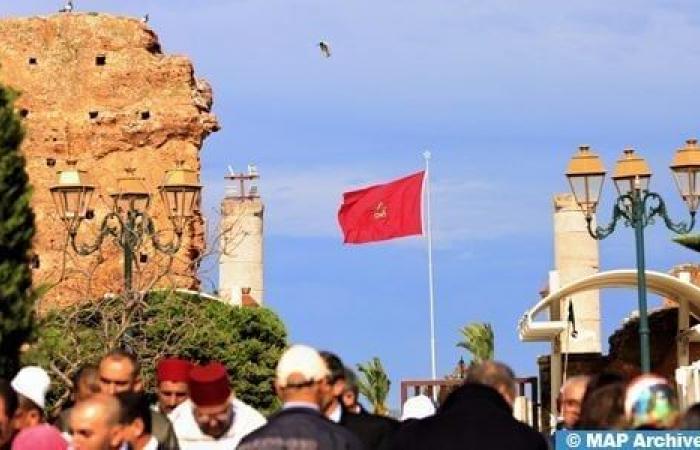Sunday, September 29, 2024 at 1:45 p.m.
Fez- The Moroccan people and the family of former resistance fighters commemorate, at the beginning of October, the 69th anniversary of the launch of the Liberation Army’s operations in the North of the Kingdom, a glorious page in national history.
Celebrated in the provinces of Boulemane, Taza, Al Hoceima and Nador, this anniversary perpetuates this glorious epic reflecting the symbiosis between the Throne and the people in the heroic struggle for national liberation, independence and territorial integrity.
The celebration of the anniversary of the launch of these operations, which will remain forever engraved in the glorious record of national resistance, constitutes an opportunity to remember this historic stage and recall the values of bravery and sacrifice of the resistance family and the liberation army for the defense of the homeland and the preservation of its identity.
The High Commission for former resistance fighters and former members of the liberation army (HCAR) recalls, in a press release, that these operations represent the natural extension of the armed resistance that the Moroccans launched in response to the decision of the colonial forces to forcing the late HM Mohammed V and his family into exile, first in Corsica, then in Madagascar.
The colonizers, through this unacceptable act, intended to nourish the designs of undoing the unwavering bond that unites the people and the Throne, and above all of extinguishing the flame of national resistance which had been rekindled throughout the country.
Following this decision by foreign forces, mass demonstrations and a huge popular uprising broke out in the different regions of Morocco to express the attachment of Moroccans to their King, their unity and the sacred values of the Nation.
Thus, the first spark of the revolution was thrown by the sons of Taza and Boulemane, who demonstrated bravery and high patriotic sense against the colonizers.
These patriots in the regions of Imouzzer Marmoucha and Taza reacted in symbiosis to the colonial diktat, by setting up resistance cells operating for the triumph of the national cause, by waging fierce battles against the colonizer and inflicting on him a bitter defeat.
Since the end of 1954, the resistance took the initiative to create cells, formations and teams for the liberation army, and training centers for handling weapons and planning attacks on colonial barracks, making the north of the Kingdom, which was under the Spanish protectorate, a field for military training and for the preparation of strategic plans to fight against foreign occupation and for the return of the hero of liberation and independence and of the first fighter, the late HM Mohammed V, from exile to the motherland.
In March 1955, the ship “Dina”, carrying weapons from the Arab East and intended for the resistance, docked in secret at Ras Al Maa (east of Nador). The men of the liberation army ensured their transport to the advanced posts of the resistance.
This operation, which marked a decisive turning point in support for the launch of the liberation army in the North and also support for the Algerian liberation movement, embodied the values of solidarity between the Maghreb countries united by a common destiny.
October 1 and 2, 1955 are significant dates which coincided with the launch of operations triggering the movement of the liberation army in the North of the Kingdom and targeting the posts of the colonizer’s army and its barracks.
The Liberation Army groups were then deployed on several fronts and carried out coordinated attacks against the posts of the colonial forces.
The valiant resistance fighters, deployed in the Rif mountains and the Taza region, inflicted heavy human and material losses on the occupying forces, particularly in Jbel Lakraâ, Bouskour, Tizi and Daren.
The heroic operations of the liberation army thus marked the beginning of the end of colonialism. Indeed, 45 days after the launch of these operations, the late HM Mohammed V returned to the motherland, on November 16, 1955, announcing, during his first speech, the good news of independence and reunification of the Kingdom: “Coming out of the little jihad (the ordeal of exile and the recovery of independence), we are back to fight the great jihad (the truly great battle of progress and development)”.
Historic visits were made to Taza on July 14, 1956, and to Nador on July 15, 1956 by the late HM Mohammed V, in recognition of the sacrifices of the martyrs and resistance fighters as well as their sacred services in the resistance fight and the March of liberation and national unity.
This commemoration is thus an opportunity to remember the epic tale, the bravery, the altruism and the sacrifices demonstrated by these resistance fighters to recover freedom, independence and territorial integrity and to increase awareness of the centrality of the rising generations. sacred patriotic values and ideals of the Nation.
In celebration of this anniversary, the High Commission has developed a rich program of activities and meetings planned from October 1 to 4 in the provinces of Boulemane, Nador, Taza and al Hoceima. During these meetings, emphasis will be placed on the bright episodes of this crucial stage of the national struggle for the liberation and independence of the homeland.
The celebrations will also affect the 46 regional and provincial delegations and local offices as well as the memory spaces (104 spaces) through the organization of meetings and conferences dealing with this historic event.






